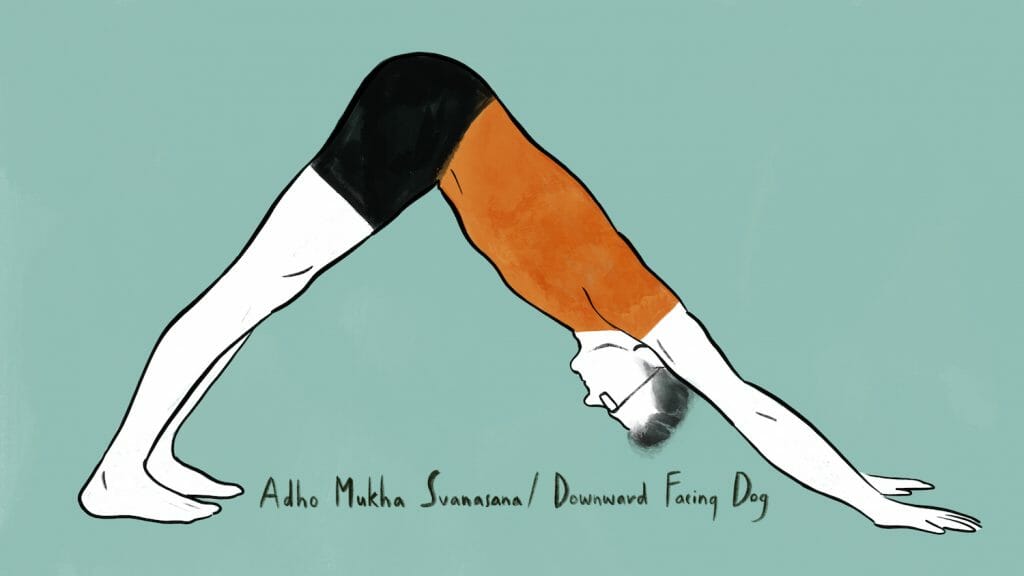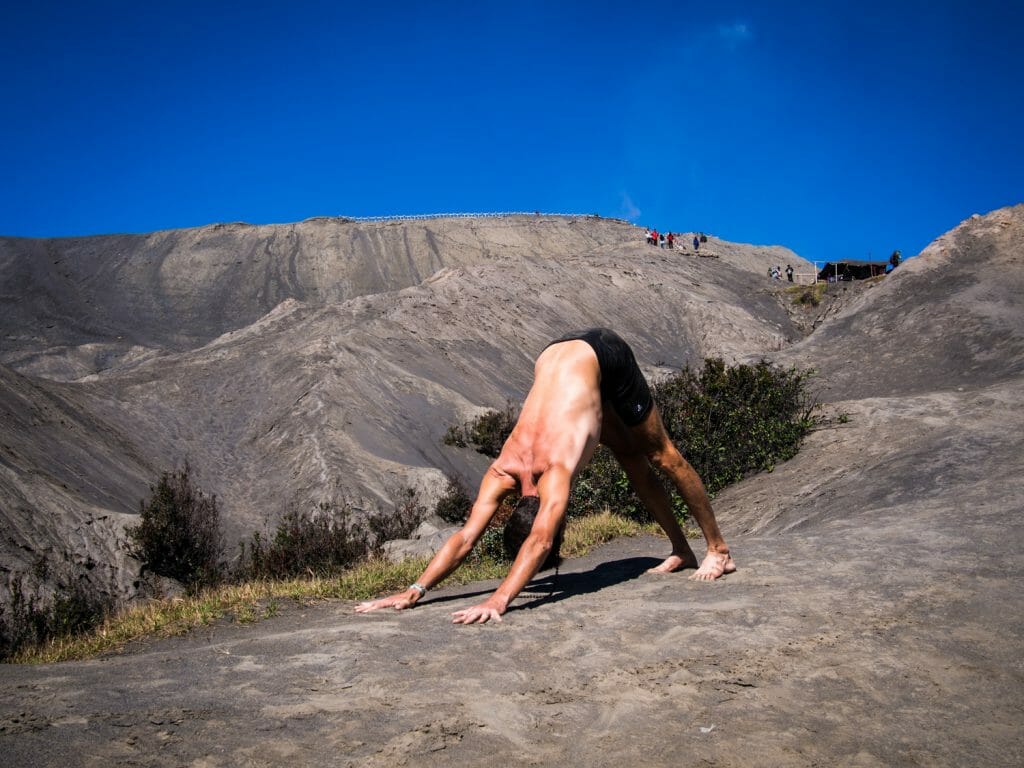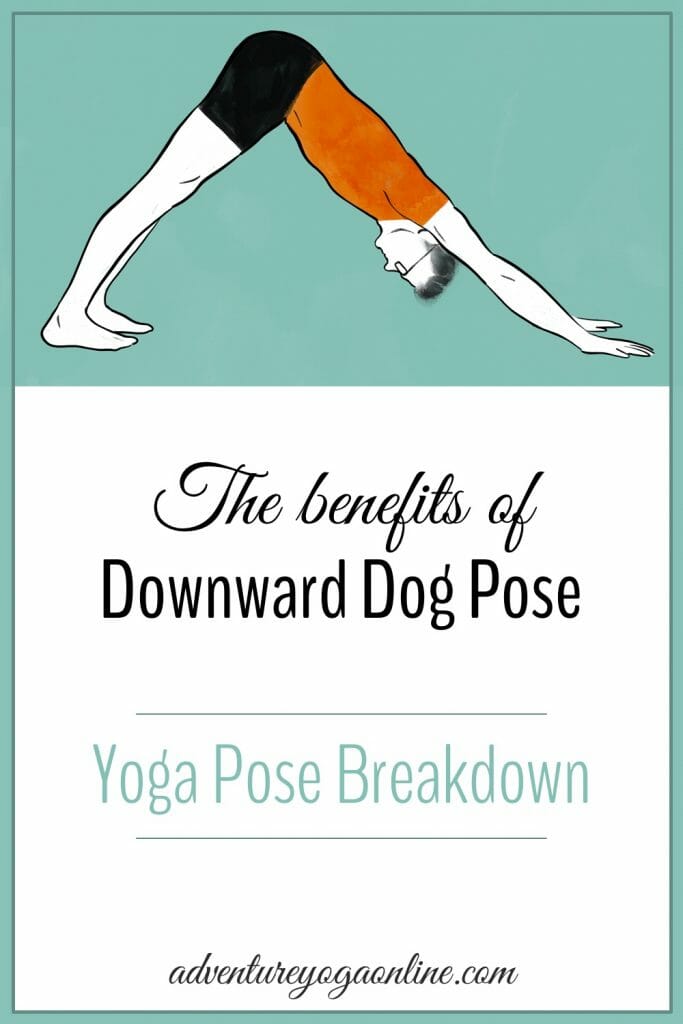Want to learn more about Adho Mukha Svanasana, aka Downward-Facing Dog? In this post, I share the benefits of Downward Dog, a complete pose breakdown, contraindications, modifications and more.

Even though Adho Mukha Svanasana (aka Downward Dog) is in pretty much every yoga class, right from the very first class you go to, it is anything but a basic pose. I am always struggling with Downward-Facing Dog — and I have been practicing yoga for more than a decade!
For me, the challenge of this pose is primarily that I seem to have tight hamstrings no matter how much I focus on lengthening them. This leads to my lower back rounding in Down Dog — so it feels like I am always working on finding the natural curves of my spine in this pose.
But, I’ve said it before, and I’ll say it again: I love that even the most common yoga poses continue to challenge me and ask more of me. If it all came easily, I know I would get bored pretty quickly with my yoga practice.
This article may contain affiliate / compensated links. For full information, please see our disclaimer here.
Downward Dog Quick Facts
| Sanskrit | Adho Mukha Svanasana |
| English | Downward-Facing Dog / Downward Dog / Down Dog |
| Pronunciation | aah-doh MOO-kah shwah-NAHS-ah-nuh |
| Meaning | Adhas means downward. Mukha means face. Svana means dog. |
Downward Dog Benefits
Note: I only include the scientifically supported benefits of Downward Dog here. Plenty of claims about other supposed benefits (from the plausible to the magical to the ridiculous) have been made. To me, pseudo-scientific claims only serve to harm the yoga community, so I choose not to give them airtime here.
The main physical benefits of Adho Mukha Svanasana include:
- A great stretch for your feet, hamstrings, calf muscles, and biceps.
- Opens and strengthens shoulders.
- Strengthens triceps and biceps.
- Helps you connect to your core.
- Can be calming after strenuous poses.
- Stretches gluteal muscles.
- Strengthen quads, hip flexors, and knee joints.
- Said to help lower high blood pressure.
- Elongates the spine when done with proper alignment.
- Helps to strengthen ankle joints.
If you want more on the benefits of yoga, see our complete guide to the benefits of yoga, which includes a history of yoga plus the origins of our modern yoga practice and much more.

Precautions & Contraindications
Remember that while yoga is for everyone, not all poses are for all people.
- If you have a wrist injury or wrist pain you may wish to avoid Down Dog. However, see Modifications below for an option that might help alleviate the pain.
- If you have high blood pressure you should not hold this pose for more than 30 seconds.
- If you have had eye surgery recently you should avoid this pose.
Misconceptions & Myths
Inversions and the lymphatic system
Despite what you may read, inversions do not cleanse your lymphatic system. The lymphatic system filters bacteria, abnormal cells, etc., from your blood and sends the clean fluid back towards your heart.
Inversions and menstruation
It is often repeated by yoga teachers, and in yoga texts, the women should never do an inversion when they are menstruating. The story told is that when you go upside down the bad blood that is being expelled by the menstrual cycle reverses flow and that this can cause health problems.
This myth dates back to a time when men decided what women should and should not do, with no reference to facts or science. I have spoken to several doctors about this and it has absolutely no basis in medical science.
If you don’t want to invert when menstruating, that’s up to you. If you want to, that’s also up to you. Inverting, just like everything else in yoga, is a choice. It’s your choice.
Downward-Facing Dog and Pregnancy
Teachers commonly advise students not to do Down Dog during pregnancy, however one scientific study found it to be beneficial. While you’re pregnant, listen to your body and do what feels good, don’t do what doesn’t feel good.
Downward Dog Yoga Pose Breakdown
How to do Adho Mukha Svanasana or Downward Dog
- Start on your hands and knees (Bharmanasana). Make the centre of your wrists as wide as the outer edges of your shoulders and make your wrists parallel to the top of your mat.
- Step your legs back one at a time, tuck your toes under, and straighten your legs. Bring your shoulders over your wrists and have your feet back far enough so that your heels are over the balls of your feet. This is Phalakasana, or Plank Pose.
- Bend your knees a little. Push down and forward with your hands and lift your hips up and back. Straighten your legs and stretch your heels back and down to, or towards, the ground. Note: If your lower back rounds here, bend your knees some so the strain on your hamstrings is less. See Modification below for more.
- Push down and forward with your hands, stretch out through your shoulders, and lift your hips up and back.
- Move your chest back towards your thighs as you lift your hips up and back. At the same time, move the front of your ribs back towards your spine. This can feel like you are rounding your back, but it is a great technique for helping find the natural curves of your spine.
- Push all 4 corners of your hands down and turn your biceps in towards each other, and even up toward the ceiling a little (externally rotate your arms). Stretch out of your shoulders.
- Bring your ears in line with your upper arms so that you have a natural curve in your neck. Lengthen through the top of your head and your neck.
- Lift your sit bones towards the ceiling, engage your quads to straighten your legs, and stretch your heels back and down.
- This is Downward-Facing Dog Pose, or Adho Mukha Svanasana.
- To come out of Down Dog bend your knees and bring them to the ground. Balasana (Child’s Pose) can feel good after holding Adho Mukha Svanasana for an extended period of time.
An advanced variation of Adho Mukha Svanasana is to bring your head down to the ground, but this tends to encourage hyperextension at the shoulder which can lead to shoulder instability. There is so much to work on in this pose without attempting to bring your head to the ground, so it’s best to save this variation until you have all the rest nearly perfect.
Modifications & Variations
If your wrists hurt:
- If you have a wrist injury or wrist pain you can use a foam wedge under your hands. This decreases the angle of extension at your wrist and can make the pose doable.
- Another great wrist modification is to place two yoga blocks against the wall. Then do Downward Dog facing the wall with your hands on the blocks. This modification makes your arms ‘longer’ and can help you find more length in your spine.
If your back rounds:
If your back rounds while doing Down Dog, bend your knees and work to find the natural curves of your spine. By bending your knees you will be able to tilt your pelvis more (stick your sit bones/butt up towards the ceiling), and then find more length for your spine.
Bending your knees in Downward-Facing Dog, combined with working on lengthening your hamstrings (in poses like Uttanasana, Paschimottanasana, Prasarita Padottanasana, etc.), will help you be able to do the pose with straight legs over time.
If your elbows bend:
You can use a yoga strap around your upper arms to help prevent your elbows from bending. Be careful not to tighten the strap so much that it forces your elbows into hyperextension (see below).
If your elbows hyperextend:
- Hyperextending in Adho Mukha Svanasana can, over time, damage your elbow joint. Hyperextension of your elbows in Downward-Facing Dog also prevents you from building strength in your your biceps and triceps in the pose.
- To help prevent hyperextension, squeeze your wrists towards each other (without moving them closer). This will encourage your elbows to ‘unlock’, or to bend slightly. You don’t want your elbows to bend excessively, but if you are used to hyperextending, it will likely feel like they are bending a lot. Work towards a straight elbow joint over time.
If your heels don’t touch the ground:
This is totally normal. Most yoga students do not have their heels on the ground in Adho Mukha Svanasana. However, one technique you can use to help get closer and closer to heels down is to fold or roll a yoga blanket and place it under your heels. As you do the pose, push your heels down into the prop.
If you have tight shoulders or a shoulder injury:
Use a yoga chair. Place the chair on your mat against a wall. Stand leg-length away from the wall (you can sit down on the ground and bring your feet to the wall to measure this, then stand up).
Face the chair, hold the back of the chair, and bring your back parallel to the ground. You may need to adjust how far away your feet are from the wall to get your back parallel to the ground.
Or use the wall. You can also modify Downward-Facing Dog by placing your hands on the wall. To do this, stand your leg-length away from the wall. You can sit down on the ground and bring your feet to the wall to measure this.
Then stand up, face the wall, and place your hands on the wall as high your hips. Push your hands into the wall and bring your back parallel to the ground. You may need to adjust how far away your feet are from the wall to get your back parallel to the ground.

Yoga Poses Related to Down Dog
Preparatory Poses
Bharmanasana / All Fours
Vajrasana / Thunderbolt Pose
Bitilasana & Marjaryasana / Cat & Cow
Phalakasana / Plank Pose
Uttanasana / Forward Fold
Ardha Uttanasana / Half Forward Fold
Garudasana / Eagle Pose
Gomukhasana / Cow Face Pose
Paschimottanasana / Seated Forward Fold
Follow-up Poses
Balasana / Child’s Pose
Dandasana / Staff Pose
Setu Bandha Sarvangasana / Bridge Pose
Supta Virasana / Reclined Hero Pose
Poses to Take Your Practice Further
Urdhva Dhanurasana / Upward Bow Pose or Full Wheel
Eka Pada Adho Mukha Svanasana / One Leg Downward-Facing Dog
Camatkarasana / Wild Thing
Purvottanasana / Upward Plank Pose
Kapinjalasana / Chathaka Bird Pose
Related Posts & Videos
- Post: Sirsasana / Headstand Benefits
- Post: Sirsasana 2 / Tripod Headstand Benefits
- Video: Adho Mukha Svanasana / Downward Dog Pose Breakdown
Gear & Further Reading
- BKS Iyengar’s Light on Yoga
- Darren Rhodes Yoga Resource Practice Manual
- Liforme Eco-Friendly Yoga Mat
- Yoloha Cork Yoga Mat with plant-based foam
- Yoloha Cork Yoga Blocks
- Organic Cotton Yoga Straps
- Foam Yoga Wedge
- Machine Washable Vegan Yoga Blankets
- Folding Yoga Chair
Save 10% on cork yoga gear
- Use our code AYO10 at checkout for 10% off all Yoloha yoga mats & gear.
Good for the planet and great for your practice!
A Final Note About Downward-Facing Dog
Sometimes you’ll hear your teach say that Downward Dog is a resting pose. When you’re new to learning this pose it can feel like anything but a resting pose! That’s because Downward-Facing Dog is a whole-body workout when done well. It uses your legs, arms, shoulders, core, feet, hands, and a lot of mental focus as well.
But once you have learned how to do this pose, it can start to become a place to reset during a vigorous vinyasa practice, or after doing a series of split leg lunge poses like Warrior 2, Side Angle, and Triangle pose.
See you on (and off) the ice OMies, Stephen ![]()
I hope this post has been helpful in expanding your possibilities with Downward-Facing Dog. It’s my goal to inspire you to explore your yoga practice more deeply while enabling you to cultivate the strength and clarity needed to live your life adventure to the fullest.

